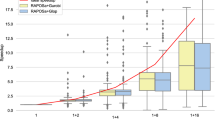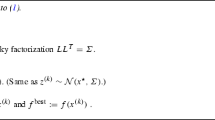Abstract
We consider low-rank semidefinite programming (LRSDP) relaxations of unconstrained \(\{-1,1\}\) quadratic problems (or, equivalently, of Max-Cut problems) that can be formulated as the non-convex nonlinear programming problem of minimizing a quadratic function subject to separable quadratic equality constraints. We prove the equivalence of the LRSDP problem with the unconstrained minimization of a new merit function and we define an efficient and globally convergent algorithm, called SpeeDP, for finding critical points of the LRSDP problem. We provide evidence of the effectiveness of SpeeDP by comparing it with other existing codes on an extended set of instances of the Max-Cut problem. We further include SpeeDP within a simply modified version of the Goemans–Williamson algorithm and we show that the corresponding heuristic SpeeDP-MC can generate high-quality cuts for very large, sparse graphs of size up to a million nodes in a few hours.




Similar content being viewed by others
Notes
Actually, simple bounds like, e.g., the sum of all positive edge weights, can always be easily provided, but they are evidently useless to evaluate the quality of a heuristic solution.
References
Barvinok, A.: Problems of distance geometry and convex properties of quadratic maps. Discret. Comput. Geom. 13, 189–202 (1995)
Benson, H.Y., Vanderbei, R.J.: On formulating semidefinite programming problems as smooth convex nonlinear optimization problems. Technical Report ORFE 1999–01, Princeton University, NJ (1999)
Benson, S.J., Ye, Y., Zhang, X.: Solving large-scale sparse semidefinite programs for combinatorial optimization. SIAM J. Optim. 10(2), 443–461 (2000)
Bertsekas, D.P.: Nonlinear Programming. Athena Scientific, Belmont (1999)
Burer, S., Monteiro, R.D., Zhang, Y.: Solving a class of semidefinite programs via nonlinear programming. Math. Program. 93, 97–122 (2002)
Burer, S., Monteiro, R.D.C.: A projected gradient algorithm for solving the maxcut sdp relaxation. Optim. Methods Softw. 15(3–4), 175–200 (2001)
Burer, S., Monteiro, R.D.C.: A nonlinear programming algorithm for solving semidefinite programs via low-rank factorization. Math. Program. 95, 329–357 (2003)
Delorme, C., Poljak, S.: Laplacian eigenvalues and the maximum cut problem. Math. Program. 62(3), 557–574 (1993)
Dolan, E., Morè, J.: Benchmarking optimization software with performance profile. Math. Program. 91, 201–213 (2002)
Fischer, I., Gruber, G., Rendl, F., Sotirov, R.: Computational experience with a bundle approach for semidefinite cutting plane relaxations of Max-Cut and equipartition. Math. Program. 105(2–3), 451–469 (2006)
Fletcher, R.: Semi-definite matrix constraints in optimization. SIAM J. Cont. Optim. 23, 493–513 (1985)
Goemans, M.X., Williamson, D.P.: Improved approximation algorithms for maximum cut and satisfiability problems using semidefinite programming. J. ACM 42(6), 1115–1145 (1995)
Grippo, L., Palagi, L., Piacentini, M., Piccialli, V.: An unconstrained approach for solving low rank SDP relaxations of \(\{-1,1\}\) quadratic problems. Technical Report 1.13, Dip. di Informatica e Sistemistica A. Ruberti, Sapienza Università di Roma (2009)
Grippo, L., Palagi, L., Piacentini, M., Piccialli, V., Rinaldi, G.: SpeeDP: a new algorithm to compute the SDP relaxations of Max-Cut for very large graphs. Technical Report DII-UTOVRM Technical Report 13.10, University of Rome Tor Vergata (2010)
Grippo, L., Palagi, L., Piccialli, V.: Necessary and sufficient global optimality conditions for NLP reformulations of linear SDP problems. J. Glob. Optim. 44(3), 339–348 (2009)
Grippo, L., Palagi, L., Piccialli, V.: An unconstrained minimization method for solving low-rank SDP relaxations of the maxcut problem. Math. Program. 126, 119–146 (2011)
Grippo, L., Sciandrone, M.: Nonmonotone globalization techniques for the Barzilai–Borwein gradient method. Comput. Optim. Appl. 23, 143–169 (2002)
Grone, R., Pierce, S., Watkins, W.: Extremal correlation matrices. Linear Algebra Appl. 134, 63–70 (1990)
Helmberg, C., Rendl, F.: A spectral bundle method for semidefinite programming. SIAM J. Optim. 10, 673–696 (2000)
Homer, S., Peinado, M.: Design and performance of parallel and distributed approximation algorithm for the Maxcut. J. Parallel Distrib. Comput. 46, 48–61 (1997)
Journée, M., Bach, F., Absil, P., Sepulchre, R.: Low-rank optimization for semidefinite convex problems. SIAM J. Optim. 20(5), 2327–2351 (2010)
Kim, S., Kojima, M.: Second order cone programming relaxation of nonconvex quadratic optimization problems. Optim. Methods Softw. 15, 201–224 (2000)
Laurent, M., Poljak, S., Rendl, F.: Connections between semidefinite relaxations of the Max-Cut and stable set problems. Math. Program. 77, 225–246 (1997)
Liers, F., Jünger, M., Reinelt, G., Rinaldi, G.: Computing exact ground states of hard Ising spin glass problems by branch-and-cut. In: Hartmann, A., Rieger, H. (eds.) New Optimization Algorithms in Physics, pp. 47–69. Wiley, London (2004)
Mittelmann, H.: An independent benchmarking of SDP and SOCP solvers. Math. Program. 95, 407–430 (2003)
Muramatsu, M., Suzuki, T.: A new second-order cone programming relaxation for max-cut problems. J. Oper. Res. Jpn 46, 2003 (2001)
Nesterov, Y.: Quality of semidefinite relaxation for nonconvex quadratic optimization. CORE Discussion Papers 1997019, Université Catholique de Louvain, Center for Operations Research and Econometrics (CORE) (1997)
Nesterov, Y.: Semidefinite relaxation and nonconvex quadratic optimization. Optim. Methods Softw. 9(1–3), 141–160 (1998)
Pataki, G.: On the rank of extreme matrices in semidefinite programs and the multiplicity of optimal eigenvalues. Math. Oper. Res. 23, 339–358 (1998)
Poljak, S., Rendl, F.: Solving the Max-Cut problem using eigenvalues. Discret. Appl. Math. 62(1–3), 249–278 (1995)
Poljak, S., Rendl, F., Wolkowicz, H.: A recipe for semidefinite relaxation for 0-1 quadratic programming. J. Glob. Optim. 7, 51–73 (1995)
Rendl, F., Rinaldi, G., Wiegele, A.: Solving Max-Cut to optimality by intersecting semidefinite and polyhedral relaxations. Math. Program. 121(2), 307–335 (2010)
Rinaldi, G.: Rudy: A graph generator. http://www-user.tu-chemnitz.de/~helmberg/sdp_software.html (1998)
Acknowledgments
We would like to thank the three anonymous referees for their valuable remarks and suggestions that helped us to improve the writing of this paper.
Author information
Authors and Affiliations
Corresponding author
Rights and permissions
About this article
Cite this article
Grippo, L., Palagi, L., Piacentini, M. et al. SpeeDP: an algorithm to compute SDP bounds for very large Max-Cut instances. Math. Program. 136, 353–373 (2012). https://doi.org/10.1007/s10107-012-0593-0
Received:
Accepted:
Published:
Issue Date:
DOI: https://doi.org/10.1007/s10107-012-0593-0
Keywords
- Semidefinite programming
- Low rank factorization
- Unconstrained binary quadratic programming
- Max-Cut
- Nonlinear programming




